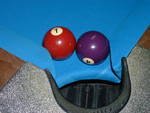You gonna need to explain that!
Your statement says the smaller a pocket gets, the easier it also gets.
1. If you aim at center pocket, the pocket opening being smaller doesn't matter much.
2. The smaller the opening, the shorter the shelf becomes. So, once you get it through the points, the ball is more apt to fall into the pocket. The wider the opening, the deeper the shelf, so, you can hit inside the points and still not make the ball.
3. The angle of the opening, and the depth of the shelf are what make a pocket easy or tough. Many think it is just the size of the opening, but that really doesn't have near as much effect as the other two do.
4. Some will say that you can't hit the rail first and still make the ball. Again, that is largely due to the cut of the opening, not so much the size. In reality, if you hit the rail first, well.....you missed the opening anyways, so why should one think it should go in on a miss?? That's just wrong thinking.
5. When I shimmed my valley barbox from 5" down to 4 1/8", I didn't even notice any difference. That is why I also had to go back and extend the shelves on each pocket. THAT made a huge difference on the pockets being tougher.




